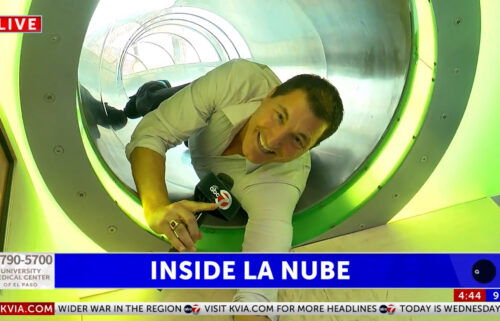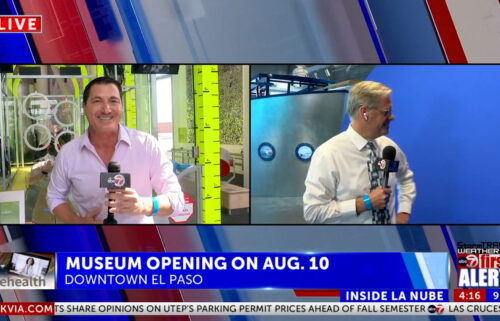A man’s mission for Mars, a mother’s love to see it through
Click here for updates on this story
MADISON, Wisconsin (madison.com/Wisconsin State Journal) — The past five years were filled with grief for Betty Willmore.
The Cambridge woman lost her husband of 66 years in 2016. Then, in October 2019, her son, an accomplished athlete and engineer, died unexpectedly from a medical incident while on his bike during a training ride in San Diego.
A few months later Willmore was again devastated when she was diagnosed with an aggressive, terminal form of cancer. The protocol for most would have been to enter hospice care and pray for a peaceful, pain-free end.
Only Willmore chose chemotherapy instead — not to somehow beat the odds but because she wanted to see an Atlas V rocket blast off for Mars with Perseverance, the much heralded rover that is now exploring the Red Planet. Her son, Jim Willmore, who was 63 when he died and a senior director of engineering at Qualcomm Technologies in San Diego, was instrumental in developing a computer chip used in the mission.
That chip is the brains and the heart of Ingenuity, a small, four-pound helicopter on which Jim’s name is inscribed along with those of others who worked on the project. The chip features a long lifespan, high computing power and low energy consumption, and it can withstand extreme temperature swings like those on Mars.
Remarkably, Betty Willmore, who turned 89 in March, not only saw the July blastoff but the landing in February of the rover that carried Ingenuity in its belly. Sadly, Willmore died Thursday just days before Ingenuity’s scheduled maiden flight.
Now you can move into an Italian house for just $12,000
The flight had been set for late Sunday or early Monday, but is now delayed until at least Wednesday, NASA has announced.
“It was super important to her,” said Tracy Punsel, Betty Willmore’s daughter and Jim’s sister. “We had champagne when it took off. It was great. And when it landed it was very bittersweet because my brother’s gone and this is his legacy. There were tears of joy and tears of loss. It was really, really hard.”
This will be Ingenuity’s first attempt at powered, controlled flight on another planet. With no science instruments onboard, the sole goal of Ingenuity is to determine whether a helicopter can fly on Mars, NASA scientists have said.
The helicopter is to run its rotors to 2,537 rpm and, if all final self-checks look good, lift off. After climbing at a rate of about 3 feet per second the helicopter will hover at 10 feet above the surface for up to 30 seconds before it descends and touches back down on the Martian surface.
Appropriately, the aircraft carries a swatch of fabric from Orville and Wilbur Wright’s airplane that recorded the first powered and controlled flight on this planet in 1903.
“Every step we have taken since this journey began six years ago has been uncharted territory in the history of aircraft,” said Bob Balaram, the helicopter’s chief engineer at the Jet Propulsion Lab, which built the aircraft.
Local roots
The Willmore name is not only now on Mars but likely familiar to many in the Madison area.
Betty and her husband Harold “Jim” Willmore owned the Grandview Resort near Esther Beach on Lake Monona from 1972 until 2005. The collection of cottages, rented to vacationers in the summer and college students and teachers during the school year, was built in the 1930s. The couple’s children, Jim and Tracy helped run the resort and when they were old enough moved from their parents’ 3,000-square-foot farmhouse built in 1900 into one of the 400-square-foot cottages on the other side of the driveway.
When the Willmores closed the resort, it was the last of its kind on the lake. In 2005 the couple sold two lots to a developer who in 2010 sold them to the city for expansion of the park. The Willmores kept another lot for themselves so they could build a new home on the Waunona Way property.
“It’s time we did something for us,” Betty Willmore told the State Journal at the time.
“Those cottages are about my age,” her husband Harold, then 75, said. “They need more maintenance and I can supply less. We could sell the whole thing, the house and the cottages, or do it this way and save a big share of what’s left of our lives.”
Jim Willmore
Jim Willmore took up running and biking after moving to California.
Jim’s affinity for computers, technology and ultimately Mars was picked up from his father, who for 26 years owned and operated Willmore’s TV Sales & Repair Service in Madison. Harold Willmore taught electronics while stationed at Great Lakes Naval Training Station in Waukegan, Illinois, during the Korean War. Later in life he became an engineer and installed computer networks for companies in Madison and throughout southern Wisconsin.
“All of my dad’s life he was into science,” Punsel said of her father. “He was a very, very smart man.”
Jim Wilmore’s path to a Mars mission began at Malcom Shabazz High School, not La Follette High School. Tracy said her brother needed an alternative to a traditional high school setting and the experience at Shabazz “was like night and day for him.”
After high school, Willmore headed to UW-Madison where he graduated with an electrical engineering degree in 1984. He immediately went to San Diego to start working in the telecommunications industry and spent the last 21 years of his life at Qualcomm, developing computer chips for cellphones and other electronic devices.
For Ingenuity, Qualcomm used its Qualcomm Flight platform that was originally developed for consumer drone technology, something that had already been rigorously tested for commercial use. The existing technology streamlined the process of integrating Qualcomm Flight into JPL’s project and not only endured Qualcomm’s own rigorous hardware testing in its labs but also passed JPL’s simulation tests for Mars.
“Without Jim’s curiosity and enthusiasm, we wouldn’t know how much risk there was in sending all of these components to space, and NASA might only roll the dice on a project like this once,” Qualcomm wrote on its blog. “Jim’s belief in taking on projects that are interesting and inspiring to his team was instrumental in the success of this collaboration.”
To the trails
It was at Qualcomm that Willmore was inspired by his colleagues to dive into biking and running. He completed 10 marathons by the age of 40, supported the Rock ‘n’ Roll San Diego Marathon since its inception and placed first in his age group repeatedly, according to his obituary. He later began doing triathlons, competed in the Madison Ironman and celebrated his 35th marathon by running the Mad City Marathon with Punsel.
He also ran the Boston Marathon three times, including the 100th anniversary in 1996, where he met his wife, Lori. The couple had one son, Travis, and he and his wife, Angie, brought two grandchildren into the Willmores’ lives.
“They’re such a blessing,” Punsel said. “It’s hard losing family. I lose my father, then I lose my brother unexpectedly, that was such a shock, and now Mom. She was so strong.”
Daniel van der Weide, a professor in the College of Engineering at UW-Madison, didn’t know Willmore but said his mental toughness to try new things and dive into highly competitive and grueling sporting events likely meshed well with his day job, especially with a high-profile project like Ingenuity, for which failure could be detrimental to a career and a company.
“I would like to celebrate that aspect of his life. The fact that he had that willingness coupled with rational expectations,” van der Weide said. “I mean, this is something for the history books, and you really have to have that special combination of qualities. It does not surprise me in the least that Jim was not just a desk jockey. This was just an expression of who he was.”
Willmore’s mother and sister didn’t learn of Jim’s work on the chip and his name being inscribed on the helicopter until 2018, four years after he began working on the project.
Punsel said that was typical of her brother, who rarely talked about his innovative work. Betty Willmore, in a story published in February by the UW-Madison College of Engineering, said she learned of her son’s impact on people at his funeral in 2019.
“People genuinely loved him,” Willmore said. “There were so many who told us how he had recruited them and mentored them and how inspiring he was. It was just wonderful.”
Please note: This content carries a strict local market embargo. If you share the same market as the contributor of this article, you may not use it on any platform.




